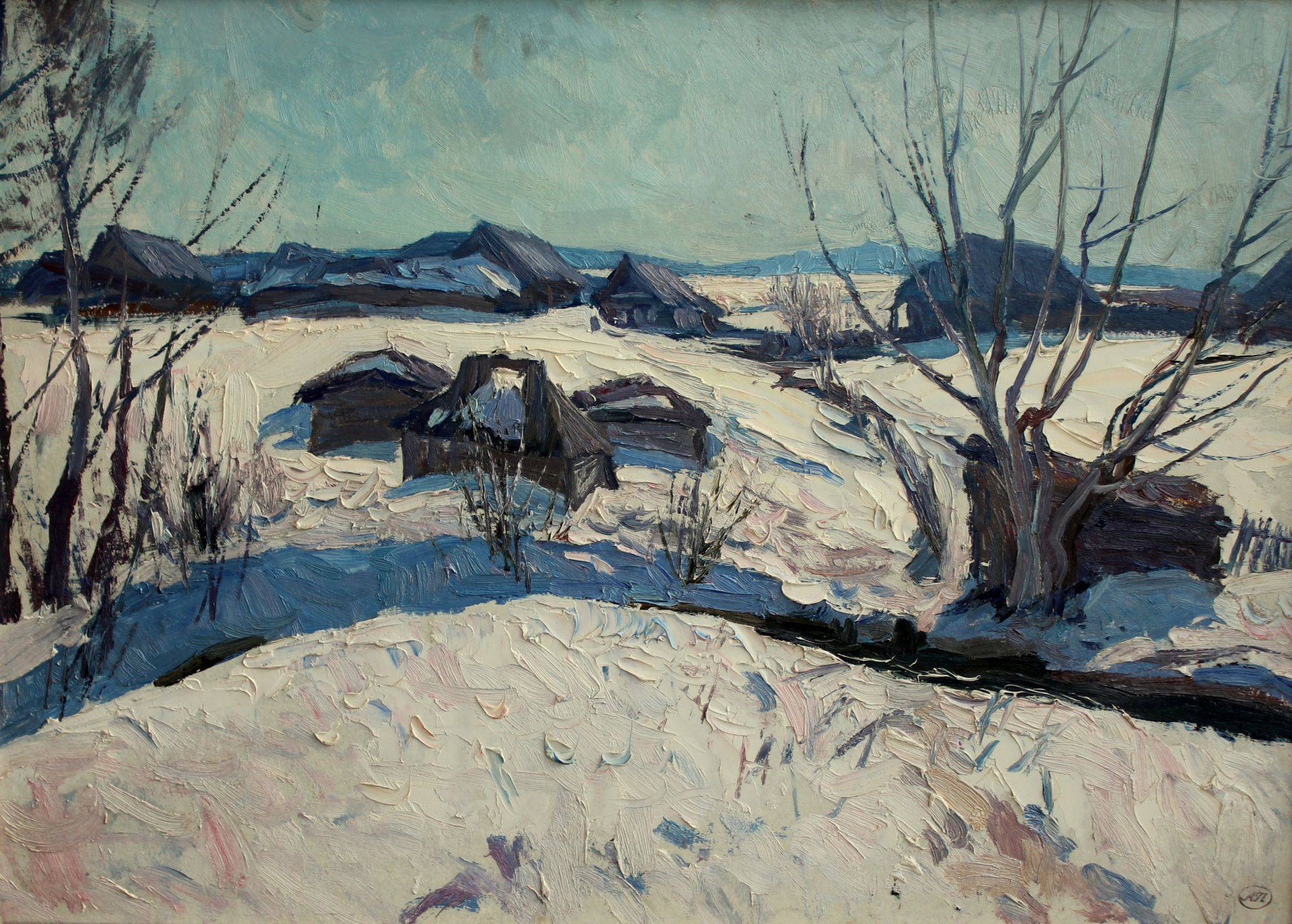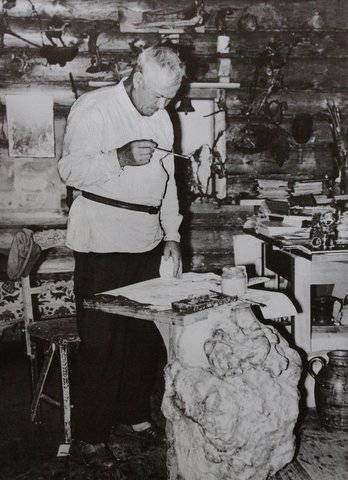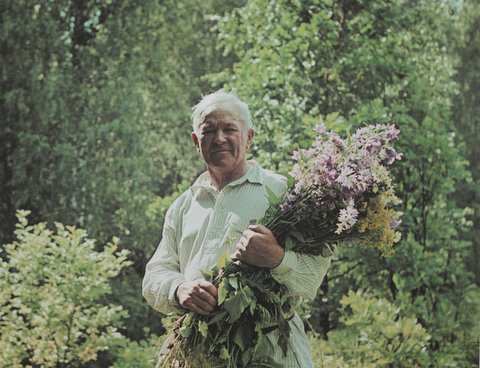March snow

Plastov, Arkadi Alexandrovich
1893 - 1972
March snow
Oil on canvas
50 x 70cm
1960's
Signed with studio stamp lower right
PROVENANCE:
Collection of the family
Regina Gallery, Moscow
Private collection, England
LITERATURE:
Certificate from the family

Plastov in his studio c 1960's
Arkadi Aleskandrovich Plastov (Аркадий Александрович Пластов) was born on January 31, 1893 into a peasant family in Prislonikha village of Ulyanovsk Region in pre- revolutionary Russia - Symbirsk. He studied drawing under D.I. Archangelsky at Symbirsk Theological Seminary (1903-1908). He entered the workshop of F.F. Fedorovsky at the Central Artistic and Industrial College in Moscow (1912-1914). During 1914-1917 he studied at the Moscow School of Painting, Sculpture and Architecture (sculpture department) under S.M. Volnukhin to which some attribute the powerful sculptural quality of his work. While there Plastov also attended classes by A.E. Arkhipov, A.M. Vasnetsov, A.M. Korin, L.O. Pasternak, A.S. Stepanov.
Arkadi Plastov gathering flowers for still life painting
The late Impressionist painters, members of the Union of Russian Artists, in particular Abram Arkhipov and Konstantin Korovin, as well as the lyrical, rich colourism of Sergey Gerasimov, had the greatest influence on Plastov. At first he worked mainly on posters and book illustration. He continued to produce book illustrations (e.g. to Lev Tolstoy’s story Kholstomer, ‘The canvas measurer’, watercolour and gouache, 1952–4; Moscow, Tret’yakov Gal.), but he achieved success mostly as a painter.
Plastov’s first significant painting was the Collective Farm Holiday (1937; St Petersburg, Russian. Museum), executed in the official Socialist Realist style of the 1930s. Yet the spirited, strikingly emotional style of painting and the liveliness of the national types compensate to a considerable extent for its propagandist content. He visited Moscow during 1927-1930 and worked at several publishing houses. In the 1930’s, a fire in Plastov's house burned all his works.
Plastov worked on placards depicting military and agriculture subjects. He painted portraits and compositions from the lives of peasants and in 1935, he painted his first large scale works. He became a member of the Union of Artists of USSR in 1937. In 1939 he worked under "Honored People of Soviet Land" for the Soviet pavilion at the World Exhibition "World of Tomorrow" in New York City. He opened a studio in Moscow in 1940.
Plastov’s famous war-time pieces, from 1941-1945, were painted during many visits to the front line. Plastov was awarded with the rank "Honored Art Worker of the Russian Federation", became First Grade State Prize Laureate (1945) and became a member of the Academy of Arts of USSR in 1947. Having the rank of People's Artist of the Russian Federation allowed him to visit France and Italy where, in 1956, he participated at the "Biennale di Venezia."
Important shows that the artist participated in include "Twenty Years of the Workers' and Peasants' Red Army" Moscow, 1938; "Industry of Socialism" Moscow, 1939; "All-Union Art Exhibition" Moscow, 1946, 1947, 1950, 1951, 1952, 1955; "Soviet Russia" Moscow, 1960. Well- known works include "Collective Farm Festival"(1937;Russian Museum); "The Bathing of the Horses" (1936-38; Russian Museum); "A Fascist has Flown Past" (1942; Tretyakov Gallery); "Harvesting" (1945; Tretyakov Gallery); "Haymaking" (1945; Tretyakov Gallery); "Collective-Farm Threshing" (1949; Kiev Museum of Russian Art); "The Tractor Driver's Supper" (1951; Irkutsk Art Museum); "Spring" (1954; Tretyakov Gallery). Plastov became a Soviet academician in 1947 and was awarded the Stalin prize in 1946 and the Lenin prize 1966. He was one of the outstanding socialist realist painter of the Stalin era whilst working in his own unique impressionist style.
Plastov was elected a full member of the Academy of Arts of USSR (1947) and won The People's Artist of USSR award in 1962. Other honors include being elected to the member of the Board of the Union of Artists of the Russian Federation and USSR, awarded the gold metal of the Ministry of Culture of USSR, honored medal of Calcutta's Society of Arts, and he was elected as the Secretary of the Board of Union of Artists of USSR.
The artist died May 12, 1972 in Prislonikha. He was awarded (after death) with the State Repin Prize of the Russian Federation (named after Repin).
March snow is a fine example of a Plastov winter scene. The artist lived all his life in the village of PRISLONIKHA where this painting is painted. When the snow started to thaw around March or April after the long Russian winter it was a cause for celebration for all the village and Plastov, who liked to paint out of doors started to venture out again. Unlike the French painters such as Gustav Courbet who paint snow very white, Plastov, and other Russian painters, include considerably more colour in the snow. In this painting Plastov sees pinks and blues in the snow and incorporates these flashes of colour with his thick impressionistic technique. The sun dances of the melting snow and the simple wooden cottages and there is feeling of a new beginning as spring hints at its arrival. Plastov is credited by Russian art historians with reintroducing Russian Impressionism into the mainstream of Soviet painting shortly after WWII and this is a good example of just such a painting.
Well-known works by Plastov include:
* Collective Farm Festival (1937; Russian Museum)
* The Bathing of the Horses (1936-38; Russian Museum)
* Harvesting (1945; Tretyakov Gallery)
* Haymaking (1945; Tretyakov Gallery)
* Collective-Farm Threshing (1949; Kiev Museum of Russian Art)
* The Tractor Driver's Supper (1951; Irkutsk Art Museum)
* Spring (1954; Tretyakov Gallery)
Awards: (partial list)
•Laureate of the Stalin prize (1946) •Lenin prize (1966) •People's Artist of the USSR (1962)
Exhibitions: (partial list)
1939, Twenty Years of the Workers and Peasants Red Army; Moscow.
1947, 1949-1952, 1955, All-Union Art Exhibition; Moscow
1960, Soviet Russia; Moscow and in 1976, 1983, 1993, 2003, Plastov's personal exhibitions were held in Moscow and in Sofia in 1964.
Collections: (partial list)
A. Plastov's artworks are kept in the State Tretyakov Gallery, the State Russian museum, the Regional art museum of Ulyanovsk, the Samara regional museum of art and in many other museums in Russia and abroad
Catalogues, Magazines, Books: (partial list)
1974 — The Tretyakov Gallery Aurora Art Publishers, Leningrad.
1975 — Paintings from the Russian Museum Collection, Aurora Art Publishers, Leningrad.
1976 — Soviet Painting 1917-1973, Soviet Artist, Moscow.
1976 - Solo Exhibit in the Central Exhibition Hall Manezh Moscow.
1977 - Solo Exhibit in the Central Exhibition Hall Manezh Leningrad (now St. Petersburg).
1978 — Art in the Soviet Union Aurora Art Publishers, Leningrad.
1979 — The Russian Museum, Leningrad. Paining, Aurora Art Publishers, Leningrad.
1982 — Kiev Museum of Russian Art Soviet Artist, Moscow.
1982 — The USSR Academy of Arts Aurora Art Publishers, Leningrad.
1982 — Land and People, Artist RSFSR (Russian Soviet Federal Socialist Republic), Leningrad.
1983 - Exhibit in Honor of the 90th Anniversary, State Tretyakov Museum, Moscow.
1985 — Catalog of the Academy of Art of the USSR, Fine Arts, Moscow.
1993 - Exhibit in Honor of the 100th Anniversary, State Tretyakov Museum, Moscow.
2000 —Soviet Fine Arts, Fine Arts, Moscow — The Soviet Character, Aurora Art Publishers, Leningrad — Umeni Sovetskeho Svazu Aurora Art Publishers, Leningrad — Art Under Stalin, Matthew Cullerne Bown, Holmes & Meier Publishers, New
A Dictionary of Twentieth Century Russian And Soviet Painters, Matthew Bown, Izomar Limited, London.
Russian Impressionism Harry N. Abrams, Inc., New York —
Soviet Impressionism, Antique Collectors Club Ltd., Woodbridge, Suffolk.
2003 - Exhibit in Honor of the 110th Anniversary, State Tretyakov Museum, Moscow.



